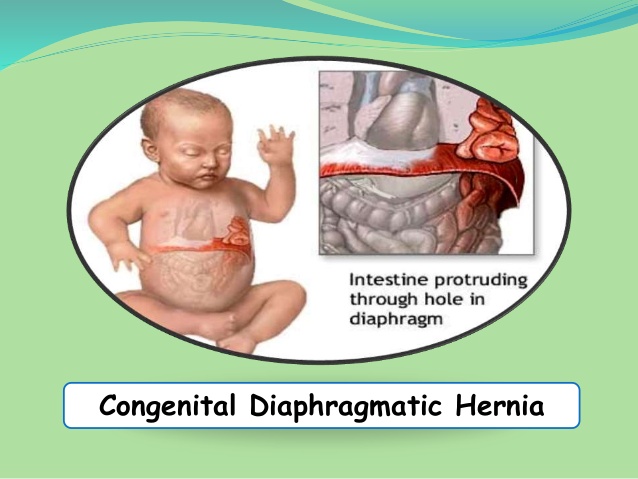The diaphragm is the muscular wall that separates chest from abdomen in human body. A congenital diaphragmatic hernia is a weak area in the diaphragm, often a hole, through which abdominal contents (such as intestines, stomach etc.) can push through and into the chest. This prevents the normal development of lungs, resulting in pulmonary hypoplasia or underdeveloped lungs. If the lungs dont fully develop, it will cause trouble breathing, GERD etc.
Symptoms of Congenital Diaphragmatic Hernia
Although every child may experience different symptoms, but the most possible symptoms include the following:
-
Difficulty breathing
-
Fast breathing
-
Shortness of breath
-
Gurgling in the chest
-
Chest pain
-
Crampy pain abdominal pain
-
Cyanosis(blue color of the skin)
-
Abnormal development of the chest, with one side being larger than the other
-
Abdomen that appears caved in
-
Severe infection
Diagnosis of Congenital Diaphragmatic Hernia
CDH is usually diagnosed in a prenatal ultrasound. If it is suspected, a fetal MRI is done to look more closely at the baby.
But in cases where it is not diagnosed before birth, it is usually diagnosed in the new-born period when the baby has trouble breathing. Doctor may suspect CDH and perform following tests to confirm:
-
A chest X-ray
-
An arterial blood gas test to evaluate baby's breathing ability
-
Other blood tests to determine a genetic problem
-
Echocardiogram (Heart ultrasound)
Laparoscopic Congenital Diaphragmatic Hernia Repair
Laparoscopic repair of the congenital diaphragmatic hernia is performed under general anaesthesia. The surgeon makes about 3-4 small incisions in the abdomen. One of the incisions is used to insert a port (nozzle) that fills the carbon dioxide gas into the abdomen to inflate it. Now laparoscope is inserted through another incision. A laparoscope is a telescope lookalike with a light and camera on the end. It allows the surgeon to clearly view inside of the abdomen on the monitor outside. After carefully evaluating the inside of abdomen, surgeon inserts other surgical instruments through rest of the incisions and repairs the diaphragmatic hernia. Repair involves reduction of intra-abdominal contents, complete resection of the hernia sac, followed by primary repair of the hernia defect, with or without mesh reinforcement. The mesh is stapled to the surrounding diaphragm edge. After completing the repair, the carbon dioxide gas is released out, and incisions are closed with sutures or staples, or covered with glue-like bandage.
Advantages of Laparoscopic Congenital Diaphragmatic Hernia Repair
-
Faster recovery
-
Minimal blood loss
-
Only few hours or overnight hospitalization
-
Sooner return to work
-
Very less pain during and after the procedure
-
Smaller incisions without any cut on abdominal muscles
-
Negligible risks and complications
-
Less chances of wound infection
-
High success rate with more than ninety-percent of symptom free patients after ten years of the procedure









